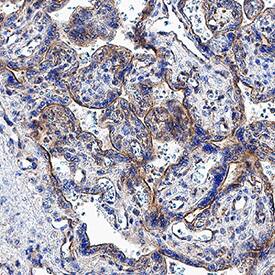Human Frizzled-10 Antibody
R&D Systems, part of Bio-Techne | Catalog # MAB3458

Key Product Details
Species Reactivity
Applications
Label
Antibody Source
Product Specifications
Immunogen
Ile21-Gly161
Accession # Q9ULW2
Specificity
Clonality
Host
Isotype
Scientific Data Images for Human Frizzled-10 Antibody
Frizzled-10 in Human Placenta Tissue.
Frizzled-10 was detected in immersion fixed paraffin-embedded sections of human placenta tissue using Mouse Anti-Human Frizzled-10 Monoclonal Antibody (Catalog # MAB3458) at 5 µg/mL for 1 hour at room temperature followed by incubation with the Anti-Mouse IgG VisUCyte™ HRP Polymer Antibody (VC001). Before incubation with the primary antibody, tissue was subjected to heat-induced epitope retrieval using Antigen Retrieval Reagent-Basic (CTS013). Tissue was stained using DAB (brown) and counterstained with hematoxylin (blue). Specific staining was localized to cytoplasm in syncytiotrophoblast. Staining was performed using our IHC Staining with VisUCyte HRP Polymer Detection Reagents protocol.Applications for Human Frizzled-10 Antibody
Immunohistochemistry
Sample: Immersion fixed paraffin-embedded sections of human placenta tissue
Formulation, Preparation, and Storage
Purification
Reconstitution
Formulation
Shipping
Stability & Storage
- 12 months from date of receipt, -20 to -70 °C as supplied.
- 1 month, 2 to 8 °C under sterile conditions after reconstitution.
- 6 months, -20 to -70 °C under sterile conditions after reconstitution.
Background: Frizzled-10
Frizzled-10, also known as CD350, is a 68 kDa seven pass transmembrane glycoprotein in the Frizzled family of Wnt receptors (1, 2). The 205 amino acid N-terminal extracellular region of Frizzled-10 contains a cysteine-rich domain that comprises the Wnt binding domain and mediates receptor oligomerization (3 - 5). The C-terminal cytoplasmic tail contains a PDZ-interaction motif (3). PDZ motifs mediate intracellular binding to scaffolding proteins. Within the cysteine-rich domain, human Frizzled-10 shares 71% amino acid (aa) sequence identity with Frizzled-9 and 31% - 46% with Frizzled-1, -2, -3, -4, -5, - 6, -7, and -8. It shares 96%, 94%, 90%, and 82% aa sequence identity with chick, mouse, Xenopus, and zebrafish Frizzled-10, respectively. Frizzled-10 is expressed during embryogenesis in the primitive streak, dorsal neural tube, developing brain, limb bud, and airway epithelium (6 - 11). It is induced by Shh and colocalizes with Shh and Wnt-7a in the neural tube (12, 13). In the adult, Frizzled-10 is expressed in placenta, gastric glands, and colon and renal tubule epithelial cells (4). Frizzled-10 associates with LRP5 to transduce Wnt-7a and Wnt-7b signals, resulting in the stabilization of cytoplasmic beta-catenin (11, 13). Frizzled-10 is also upregulated in some cancers and transformed cell lines (4, 14). It binds hypoxia inducible gene 2, which promotes oncogenic Wnt signaling and functions as an autocrine growth factor for renal cell carcinomas (15).
References
- Kikuchi, A. et al. (2007) Cell. Signal. 19:659.
- Wang, H. et al. (2006) Cell. Signal. 18:934.
- Koike, J. et al. (1999) Biochem. Biophys. Res. Commun. 262:39.
- Nagayama, S. et al. (2005) Oncogene 24:6201.
- Dann, C.E. et al. (2001) Nature 412:86.
- Kemp, C.R. et al. (2007) Dev. Dyn. 236:2011.
- Kawakami, Y. et al. (2000) Mech. Dev. 91:375.
- Nasevicius, A. et al. (2000) Mech. Dev. 92:311.
- Moriwaki, J. et al. (2000) Biochem. Biophys. Res. Commun. 278:377.
- Stark, M.R. et al. (2000) Mech. Dev. 93:195.
- Wang, Z. et al. (2005) Mol. Cell. Biol. 25:5022.
- Nunnally, A.P. and B.A. Parr (2004) Dev. Genes Evol. 214:144.
- Kawakami, Y. et al. (2000) Dev. Growth Differ. 42:561.
- Saitoh, T. et al. (2002) Int. J. Oncol. 20:117.
- Togashi, A. et al. (2005) Cancer Res. 65:4817.
Alternate Names
Gene Symbol
UniProt
Additional Frizzled-10 Products
Product Documents for Human Frizzled-10 Antibody
Product Specific Notices for Human Frizzled-10 Antibody
For research use only
